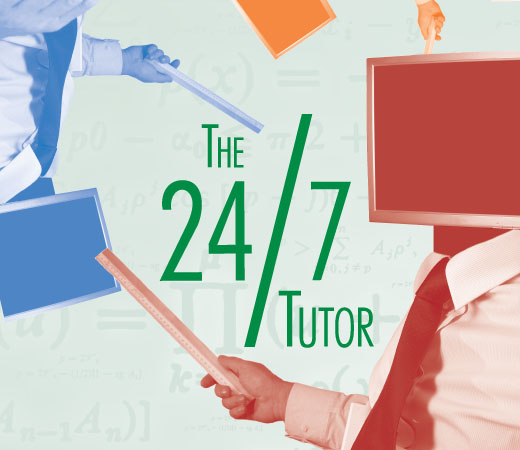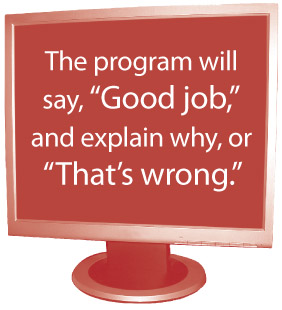The 24/7 Tutor
+ BY THOMAS K. GROSE
Interactive courseware guides students through Statics at their own pace.
Many engineering educators are embracing research-proven active-learning techniques — hands-on activities and in-class demonstrations — to help motivate students and give them a deeper conceptual understanding of abstract underlying principles. It would seem that active learning is well-suited to Statics, which teaches methods for measuring the forces between bodies. Often the first engineering course students take after freshman physics, it requires solving thorny math-based problems, as well as grasping tough concepts. But Statics is typically taught in lecture halls to hundreds at once, whereas active learning works best in small classes.
Enter Paul S. Steif, a professor of mechanical engineering at Carnegie Mellon University, and Anna Dollár, an associate professor of mechanical engineering at Miami University, Ohio. They’ve developed pioneering online courseware for Statics that uses computer- and Web-based technologies — particularly interactive virtual tutors, as well as simulations and real-time assessments — to embed active-learning techniques into lecture-hall-size classes. And results so far look good.
Use of virtual tutors is still somewhat virgin territory, even amid an explosion of digital technology in education. Steif and Dollár are the first to combine the technology into a progressive narrative that covers an entire course.
“Theirs is very developed. It’s actually an online textbook,” says Christine Valle, director of the Women in Engineering program at Georgia Tech and a member of a team of virtual-tutor researchers. Autar Kaw, a professor of mechanical engineering at the University of South Florida who also designs engineering courseware, says, “When it comes to virtual tutors . . . no others are at the level of Paul and Anna’s.”
How does the Steif-Dollár Statics course work?
Outside of class, relative concepts, skills, and methods are explained to students in online modules using text, graphics, videos and animated simulations — some interactive, some not. Next, students are given 10 to 15 problems to solve, or learn-by-doing exercises, each broken down into easy-to-grasp pieces. Each quiz also includes a walkthrough that employs animation. And here students are guided by virtual tutors — the courseware contains around 300 of them — that offer hints and feedback. When students get a correct answer, they’re given an encouraging “Good job,” but also an explanation of why the answer was correct — just in case they made a lucky guess or got a right answer but took a wrong route. If students make a mistake, sometimes they’re given a generic “That’s wrong”; other times they may get a more detailed response.
‘Did I get this?’
Students can also receive hints. The tutor reminds them of the underlying principle, shows how that principle is linked to the problem at hand, and can actually provide answers, showing graphically how they were achieved. Some of the tutors also employ “scaffolding,” a process that runs a student through a series of mini-steps to a solution. Students can redo problems as many times as they want. “It is very self-paced, self-regulating learning,” Dollár says – a luxury lecture halls usually don’t afford.
If a student feels he or she has mastered a concept after completing half the problems in a module, the rest can be skipped. How do students know if they’ve nailed it? The program also has a “Did I Get This?” feature that instantly provides an assessment of how well they understand the concept at hand.
The self-assessment software spares students the embarrassment of admitting ignorance in front of classmates. “No one wants to raise their hand to say, ‘I don’t get this,’” says computer engineering junior Shiloh Womack, one of Dollár’s students. And yet if students don’t request an explanation, they risk making a mistake on homework or, worse still, in an exam. With the self-assessment application, “you can see right away if you got it or not,” says Womack. However, it’s important that students use it; Steif and Dollár have found that students who made the greatest use of the self-assessment tool later had significantly higher exam and in-class quiz scores than students who eschewed the self-assessment activities or did very few of them.
For instructors, the courseware includes a “learning dashboard” with aggregate and individual data from the whole class. Immediately, a teacher can see if there are areas that have stumped large portions of the class. Data will show where students made the most mistakes and which learning objectives gave them the most trouble, Dollár explains. That pinpoint knowledge allows instructors to spend valuable class time on vexing topics, not on material most students have mastered. It also frees them to spend more time on design projects or demonstrations that go beyond basic understanding. “I can take things to a higher level in class,” Dollár says. “I am in the class for the difficult problems.”
Steif and Dollár’s courseware is based on another teaching method that’s gaining traction among educators: the inverted classroom, where students use study time going over materials, — often delivered as videoed lectures, — that traditionally would have been presented in class. Class time can instead be devoted to discussions or projects.
A ‘huge push’ for innovations
Smart, resourceful students know how to ace exams by memorizing information and formulas, while utterly failing to understand the concepts behind them. “We are certainly very aware of that,” Steif says. So he and Dollár drew from a Statics Concept Inventory that Steif developed based on test results from many institutions. “That gave us a good understanding of what common misconceptions students have,” Dollár says. “It is really impossible to answer a question correctly if you don’t understand the principle underlying it.”
Dollár thinks that the software’s greatest selling point is its round-the-clock accessibility. “The most important thing is it’s always there. It’s 24/7.” Georgia Tech’s Valle says online-based teaching tools also fit students’ digital lifestyles. “Students are so used to virtual, online worlds. That’s why there’s a huge push to capitalize on online innovations.”
Steif and Dollár designed the Statics course at the request of CMU’s Open Learning Initiative (OLI), which develops intelligent tutoring systems, virtual labs, and simulations to give students in a variety of disciplines more opportunities for feedback and assessment. Both use the courseware, as do instructors at around 10 other schools. It’s free and requires very little setup, apart from teachers having to register their students.
Beyond Statics, Steif and Dollár believe their Web-based, inverted-classroom software could be readily adapted to many other engineering courses, particularly those typically taught in lecture halls. Steif cautions, however, that “it is sometimes challenging to convert desirable student activities into ones that can be done — and can be evaluated — by the computer.” Their approach points to a new direction in engineering education, they say.
Shiloh Womack’s verdict? “It’s awesome.”
Thomas K. Grose is Prism’s chief correspondent, based in London.
Category: Teaching

